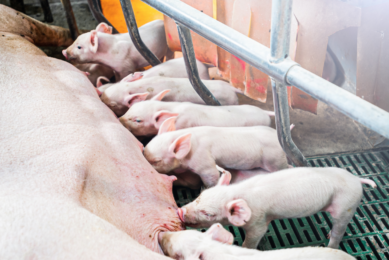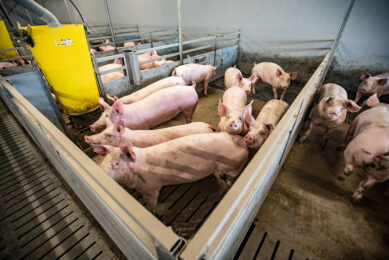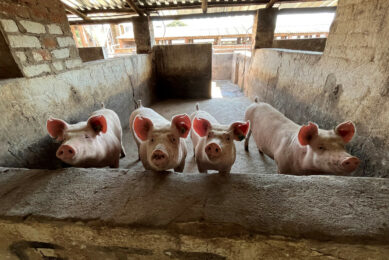Q4 2017: Will 2018 bring optimism or pessimism?

With the 4th quarter of 2017 just having drawn to an end, and with the new year having just arrived, it’s time to look back and to look ahead to what 2018 might bring. The global pig industry has generally fared well in the last 12 months, writes Dr John Strak, global pork market expert.
In 2017, we haven’t seen any major disease outbreaks; global trade, consumer spending and economic growth have been on the up; and there has been a favourable climate for investment. And, as evidence for the view that the global pig industry is in good heart, the 3 big exporters, USA, Canada and Denmark have all seen expansion in their breeding herds in 2017 – albeit that pig prices in these countries have been weakening in the 2nd half of this year, see e.g. Figure 1. As a whole, the EU breeding herd is also expanding (estimated from the June 2017 census results). In short, everything went right.
Figure 1 – US daily hog prices, April 2010 – Dec 2017.

Pig outlook for 2018: Positive or negative?
Looking forward, the outlook for 2018 depends, perhaps, on your attitude to life, is the glass half empty or half full? It’s a time to be cautious, in my opinion: the glass is half empty and the source of a refill is not obvious. But others may see 2018 as a year offering opportunities for more expansion and investment. I will set out my reasons below to be cautious about the outlook for 2018, and one reason to be cheerful.
If we pause to think about the fundamentals, it appears that there was sufficient incentive in the prices and margins paid to the major pig meat exporting nations in late 2016 and early 2017, for their breeding herds to expand in 2017. There has also been a boom in exports to China – not least for that problem child of the meat carcass, the 5th quarter (variety meats). These observations are all related: indeed, there is cause and effect.
The growth in sales of variety meats (the difficult to shift parts of the pig’s carcass) to China was a key driving force behind pig prices across the world in the 2016/17 period and its influence on farmer and packer margins can’t be overstated. But that boom in exports to China slowed in 2017 and this is my first reason to be cautious, also see Figure 2.
Figure 2 – Total monthly Chinese pigmeat imports, 2012 – Oct 2017.
The growth in pig meat sales to China went down in 2017
Month by month from about April onwards in 2017, the rate of sales of western-sourced pig meat to China declined in 2016 and at the time of writing, the year to date levels of imports into China were down by around 20% in the first 10 months of 2017. When an important part of the export demand for pig meat slows it’s a signal that should not be ignored: caution, possible general slowdown ahead. I predict that China’s imports will show a decline of about between 15-20% in 2017.
It’s fair to say that although the export sales to China have declined from 2016 this prediction still implies around a million tonnes of extra imports compared with the 2011-14 ‘norm’ for China, i.e. before its domestic herd began reducing as new environmental rules kicked in and before new, large ‘modern agriculture’ pig enterprises in China could expand. Crucially, this extra million tonnes represents about 13% of the current annual total global trade in pig meat.
That is a big number going to one customer where the market information is very much less than perfect. That’s another reason to be cautious – going in to 2018 we know much less than we should about how a key customer for pork in the global market is behaving.
Another key feature: Luck
This discussion of global exports in 2017 reminds me of another key feature – luck. As noted, in 2015 the Chinese authorities began implementing new regulations to control pollution on hog farms. Sow numbers fell as small scale pig farmers were forced out of business and China’s pork supplies shrank – and import demand rose.
At the same time we saw Foot-and-Mouth Disease (FMD) in South Korea, and Porcine Epidemic Diarrhoea (PED) in Japan and Mexico. All of these events had an impact on local pork supplies in countries that had an existing import infrastructure and Lady Luck timed these contractions with a general expansion of North American and European pig meat supplies.
Figure 3 – Chinese hog price, 2009 – Oct 2017 (deadweight, weekly).

US and European processors have talked openly about how China’s consumers have become crucial to their pig prices and, effectively, a potential downturn in the global pig price cycle was avoided. Although the dramatic changes of 2016 were not carried through to the end of 2017, there was enough momentum to keep prices looking good for the 1st half of the year.
Figure 4 – Chinese hog slaughter & breeding herd, April 2010 – Oct 2017.

Prices weakened and the market balance is changing
But in 2017 the momentum has, in my view, weakened. Has the luck run out? This question makes me cautious on the outlook for 2018. Prices have been weaker and the fundamentals of the market may have changed.
Furthermore, global supply is increasing and if the key exporters are expanding their herds and inventories in 2017, the new year will need to find ‘another China’ to absorb increased supplies of pig meat. Or, to put it another way, is Lady Luck still smiling?
What will politics bring in 2018?
Another reason to be cautious arises from the political discourse in 2017. The consensus that global trade liberalisation is positive for consumers has been challenged by US President Trump and progress towards one free trade agreement has been halted (see e.g. the Trans-Pacific Partnership, TPP), also the North-Atlantic Free Trade Agreement (NAFTA) is being renegotiated, the World Trade Organization (WTO) is being questioned, and a trade war with China has been mooted.
This is not funny. For those whose only commercial experience of global trade (since 2000) has been liberalisation and civilised discourse a shock could be in store. I can remember ‘trade wars’ between the USA and the EU, and the USA and Canada that have caused significant extra costs to businesses.
What’s more, in the UK and Europe, Brexit could easily become the first example of a reversal of a significant free trade agreement in the world. All of this might just seem like political blah blah but businesses in the pig meat value chain need to factor in the uncertainty that politicians create – and their decision-making ability. Do not be complacent.
Disruptions in normal trade patterns
A poor political judgement in the NAFTA renegotiation talks or in the Brexit discussions between the UK and the EU could easily lead to a major disruption in what were previously thought to be ‘normal’ trade patterns.
This is a new factor for business. When I look at the political actors in these dramas I would put the chances of such poor judgement(s) to be as high as 30-40%. Again, that suggests a cautious outlook for 2018.
Reasons to be cheerful
I noted at the start of this review that I would offer one reason to be cheerful about the direction of the market in 2018. In 3 words it’s, ‘global economic growth’. In its most recent statement the International Monetary Fund (IMF) observes that the global economy has been doing reasonably well. Its forecast from last October is of 3.6% growth this year, and 3.7% next year. I think it could break 4%.
These numbers will be revised in the World Economic Outlook Update in January 2017 and my bet is that they will be revised upwards. Indeed, even before any revision, one of the features of the global export markets in 2017 has been the way in which many smaller markets for pig meat have been showing strong demand for imports from the larger exporters.
Figure 5 – Global pig price cycle, Jan 2011 – Dec 2017.

Markets and consumer incomes are healthy
Some of this growth has occurred because of local disease outbreaks or productivity issues and some because bilateral FTAs have started to have an impact but I believe that a lot of this growth is occurring because markets and consumer incomes are in rude economic health. This matters: and the IMF’s positive view of the world’s economic situation also matters. More economic activity and improving consumer incomes is a reason to be cheerful for the global pig industry.
The charts I present here illustrate some of the key drivers for the global pig price and global trade in 2018. They are not the only statistics that matter but they are an important part of the story. As we begin the new year I suggest that a regular review of these data will be a useful way to deal with the uncertain outlook for 2018. Whatever time you might have to look at the numbers I wish you a peaceful and prosperous time in 2018.












